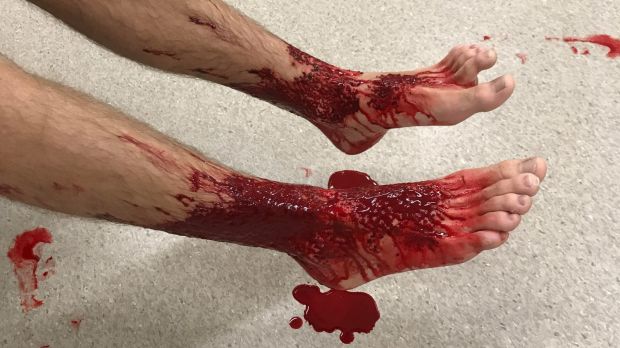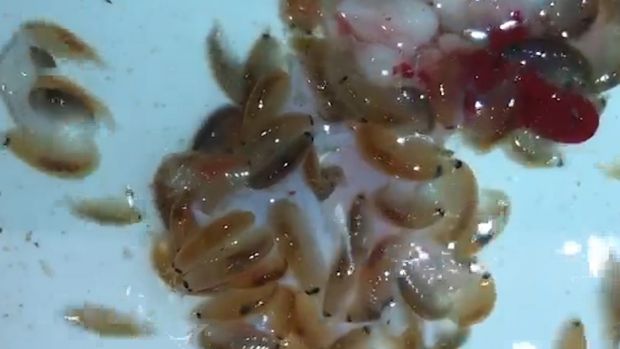WARNING: graphic images below
As his teenage son recovers in hospital after apparently being bitten by sea fleas, a Melbourne father has filmed a swarm of the flesh-eating creatures he captured at the same beach going crazy for raw steak.
More Environment News Videos
Warning, graphic images: 'Something ate Sam's legs'
Graphic image warning. After a swim at Brighton Beach, Sam's legs were eaten by something in the water. His dad went back down to the beach to find out what bit his son, this is what he found.
Sam Kanizay emerged from a dip at a Melbourne beach on Saturday night with his legs covered in blood seeping from dozens of tiny wounds on his calves and feet.
Desperate for answers, his father Jarrod Kanizay returned to Brighton Beach on Sunday night armed with a pool net, wetsuit and pieces of steak.
The result is a stomach-churning video showing dozens of sea fleas devouring Mr Kanizay's bait.
"We found thousands of little mite-type creatures in our net," Mr Kanizay said.
"We put them in an Esky and brought them home and looked at them intently and let them swim in white dishes with red meat.
"Interestingly, overnight they've essentially all clung to the meat and have been busy overnight eating it."

Sam, 16, continues his recovery at Dandenong Hospital after doctors struggled for most of Sunday to control the bleeding.
Mr Kanizay said staff at both Dandenong Hospital and Sandringham Hospital, where Sam was first taken, were stumped by the case.

"They took a biopsy yesterday to make sure there are no critters living inside.
"One would assume no and that he's going to be fine but we're taking every precaution.

"Both at Sandringham Hospital and also Dandenong Hospital, no one had seen anything like this before and they're all pretty fascinated by it."
'There are a lot of bait fish around'
Brighton Iceberger Paul Duckett, who swims at the same Dendy Street beach every day, said the alleged sea fleas incident was "bizarre" and locals had asked his group whether they would still swim on Monday.
But the dozen or so winter regulars had "shrugged it off" and, despite the extreme cold, swam straight out as normal from the beach.
"We're probably too gritty and tough and old for those creatures to worry about," he said.
Mr Duckett, who's been swimming at Brighton since 2001, admitted "the amount of blood shown" in the photos of Sam was bizarre and what had caused it was a mystery.
"We swim there every day and we're in the water for anything from 15 to 30 minutes, and no one's ever experienced anything like this," he said.
"There are a lot of bait fish around at the moment so whether there's some smaller creature that the bait fish are chasing ... "
Mr Duckett said in summer you get the "occasional" sea louse, but he believed they were normally present in warm water, and caused itchiness, not bleeding.
"This was a first, so that's why I query whether it's sea fleas or some other creature that have caused the issue."
He said his group saw a shark about once or twice a year – "sometimes they swim right under us, they're not big".
They see sting rays "every day, either lying on the bottom or swimming underneath us".
Several regular stingrays are between one and 1.5 metres wide but Mr Duckett does not believe they're dangerous.
"You leave them alone, they leave you alone," he said.
However a fellow Iceberger had once stood on a stingray lying in the sand and got a barb through his foot.
"The wound swelled up and he was in a lot of pain."
They soaked the foot in hot water, cleaned the wound and took the man to hospital, but there wasn't much bleeding.
He said on weekends, Dendy Street was a popular beach for footballers and netballers to use to recover from aches and pains.
'They're scavengers'
While sea fleas are suspected of being the creatures that bit Sam's legs, it's still unclear who is responsible for investigating the matter.
The Environment Protection Authority only does water monitoring in summer and will only become involved if the issue is pollution-related.
The Department of Environment, Land, Water and Planning told Fairfax Media it couldn't become involved as the cause was yet to be identified.
Mr Kanizay said Sam was "in good spirits" and said he hoped a marine expert would come forward in the coming days to establish what sort of creature ate his son's legs so it "doesn't happen to anyone else".
"We're a really positive family and we expect a full recovery," he said.
University of Melbourne marine biologist Professor Michael Keough said sea fleas were a possibility.
"They're scavengers who'll clean up dead fish and feed on living tissue," Professor Keough said.
"They're mostly less than a centimetre long, and so the bites they make are pretty small, and so that's more consistent with pinprick size marks."
"It's just food for them. Especially if he's been standing around for a long time, it's the chance for more of them to come in and start biting.
"[They will] just be attracted to a little bit of blood. And if he's standing in the water and he's cold [he] may not notice a whole lot of little bites."












